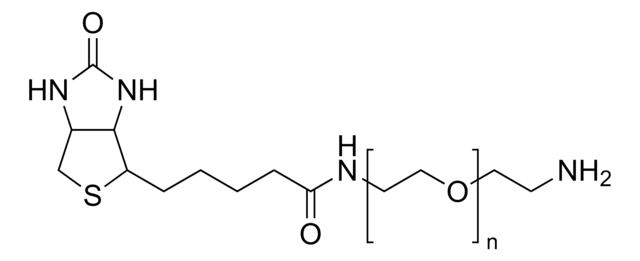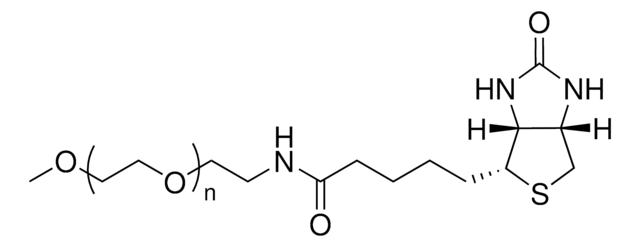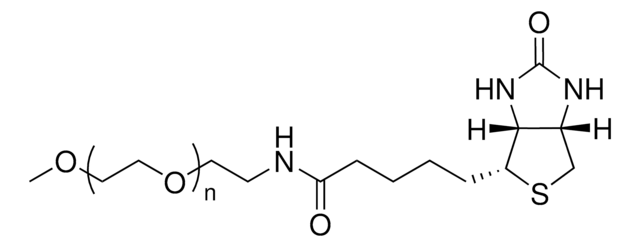757799
Poly(ethylene glycol) (N-hydroxysuccinimide 5-pentanoate) ether 2-(biotinylamino)ethane
average Mn 3,800, cross-linking reagent amine reactive, NHS ester, biotin
Synonym(s):
Polyethylene glycol, Biotin polyoxyethylene maleimide, Biotin-PEG, Biotin-PEG maleimide, Biotinylated PEG, NHS - protected acid PEG, Poly(ethylene glycol) (N-hydroxysuccinimide acetic acid) ether biotin, biotin carboxylic acid PEG, protected valeric acid
About This Item
Recommended Products
Product Name
Poly(ethylene glycol) (N-hydroxysuccinimide 5-pentanoate) ether 2-(biotinylamino)ethane, average Mn 3,800
form
solid
Quality Level
mol wt
PEG average Mn 3,400 (n ~ 77)
average Mn 3,800
reaction suitability
reagent type: cross-linking reagent
reactivity: amine reactive
mp
45-53 °C
Ω-end
NHS ester
α-end
biotin
polymer architecture
shape: linear
functionality: heterobifunctional
storage temp.
−20°C
Looking for similar products? Visit Product Comparison Guide
General description
Application
Storage Class Code
11 - Combustible Solids
WGK
WGK 3
Flash Point(F)
Not applicable
Flash Point(C)
Not applicable
Regulatory Information
Choose from one of the most recent versions:
Certificates of Analysis (COA)
Don't see the Right Version?
If you require a particular version, you can look up a specific certificate by the Lot or Batch number.
Already Own This Product?
Find documentation for the products that you have recently purchased in the Document Library.
Articles
Hydrogel-based biomaterials for cell delivery and tissue regeneration applications are discussed.
Designing biomaterial scaffolds mimicking complex living tissue structures is crucial for tissue engineering and regenerative medicine advancements.
Our team of scientists has experience in all areas of research including Life Science, Material Science, Chemical Synthesis, Chromatography, Analytical and many others.
Contact Technical Service







![O-[2-(Biotinylamino)ethyl]-O′-(2-carboxyethyl)undecaethylene glycol ≥95% (oligomer purity)](/deepweb/assets/sigmaaldrich/product/structures/445/096/aadb4590-ea90-4e6c-835d-a9aef2828e9a/640/aadb4590-ea90-4e6c-835d-a9aef2828e9a.png)